Visiting Research Scholar Spotlight: Jonathan Skaff
I have been a visiting research scholar at ISAW this academic year, and have dedicated my time to researching and writing the Seventh Annual M.I. Rostovtzeff Lecture Series, which I delivered in late March and April. The series title was Silk Roads and Steppe Roads of Medieval China: History Unearthed from Tombs, and involved four lectures demonstrating how recently-excavated tombs in China and Mongolia contain artifacts, paper documents and stone epitaphs that can deepen our knowledge of cultural exchanges in Eastern Eurasia.
My adventures researching the fourth, and final, lecture will be the topic of this post. The research was inspired by ISAW Associate Professor Sören Stark who made me aware of the discovery in 2009 of a remarkable tomb in Mongolia constructed and furnished in the style common during China’s Tang Dynasty (618-907). Among the burial objects in the tomb was a Chinese-language epitaph carved on stone that followed the conventions of Tang funerary writing. The epitaph is an amazing find because it is the only dated seventh-century textual source discovered in Mongolia and revealed the tomb was the final resting place of Pugu Yitu (635-678), leader of a nomadic Turkic tribe in Mongolia allied with the China-based Tang Dynasty.
Thanks to generous research support from ISAW, I was able to visit Mongolia in June to complete my research for publication in Princeton University Press Rostovtzeff Series. The trip was a great success. I spent five days in Mongolia’s modern capital of Ulaanbaatar. At the International Institute for the Study of Nomadic Civilizations, I met Dr. Aiuudain Ochir, the lead archaeologist on the Pugu excavation. He gave me a copy of the excavation report and answered many questions. Most importantly, I learned that Pugu’s burial was a cremation. In contemporary China, the deceased was inhumed in the tomb, while Turkic elites were cremated. Thus, even though the form and many of the contents of Pugu’s tomb appeared Chinese, the funeral ritual was in keeping with Turkic traditions.
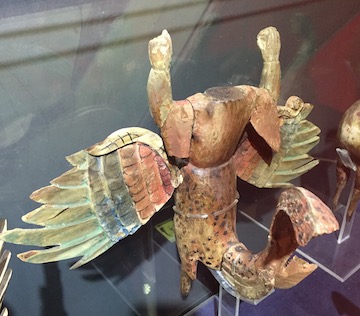 Also in Ulaanbaatar, I also spent three days at the Zanabazar Museum of Fine Arts where Pugu’s tomb epitaph and artifacts are on display. Though most were typical of provincial Tang tombs, such as the miniature terracotta honor guard, a few were unusual and particularly interesting. The greatest surprise was a pair of wooden birdmen, both missing heads, which mixed a human’s torso and arms with a bird’s wings, lower body and long tail. As far as I know, this type of figurine has not been discovered in China, though artwork depicting birdman deities occur in China and other parts of Asia.
Also in Ulaanbaatar, I also spent three days at the Zanabazar Museum of Fine Arts where Pugu’s tomb epitaph and artifacts are on display. Though most were typical of provincial Tang tombs, such as the miniature terracotta honor guard, a few were unusual and particularly interesting. The greatest surprise was a pair of wooden birdmen, both missing heads, which mixed a human’s torso and arms with a bird’s wings, lower body and long tail. As far as I know, this type of figurine has not been discovered in China, though artwork depicting birdman deities occur in China and other parts of Asia.
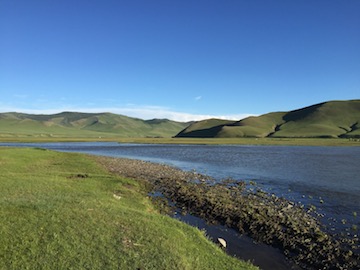
The remainder of my time in Mongolia was spent seeking to deepen my knowledge of Turkic funerary practices, mainly at Kharkhorin, 225 miles west of Ulaanbaatar. Kharkhorin is located in the Orkhon River Valley where the nomadic Turk, Uighur and Mongol Empires had their imperial centers.
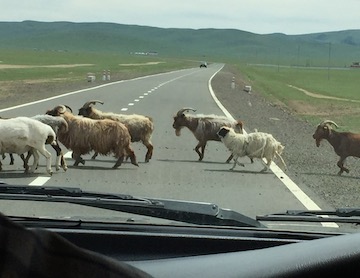
To reach my destination, I travelled via automobile through the vast and beautiful Mongolian steppe where I observed Mongolian cowboys herding their flocks.
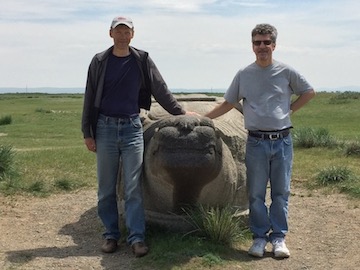
While in Kharkhorin, my host was 2014-15 ISAW VRS, Jan Bemmann. He and his archaeological team are creating a geo-magnetic map of underground sites at the thirteenth-century Mongol Empire capital of Karakorum. Having seen the current draft of the map, I can attest that it is impressively detailed and, when complete, will guide site selection of excavation sites for many years to come. While there, Jan gave me a tour of the Karakorum site. Here’s a picture of us standing next to a giant turtle statue that at one time served as a based for an inscribed stone stele.
North of Kharkhorin, I visited the memorial sites of the Turk ruler, Bilga Qaghan and his younger brother, Kul Tegin. Though a joint Mongolian-Turkish team excavated the sites in the early 2000s, the final excavation report has not been published. Visits to the on-site museum, Kharkhorin Museum , and National Museum of Mongolia allowed me to examine stone statues and steles, and a hoard of gold and silver objects from the sites.
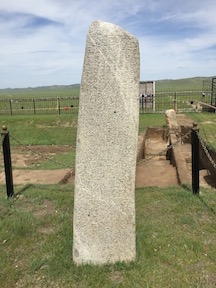
On my last full day in Mongolia, an archaeologist, Dr. Turbat Tsagaan, took me on a trip to the memorial of Tonyukuk, who was Bilga Qaghan’s sage adviser, about 90 miles southeast of Ulaanbaatar. A joint Mongolian-Turkish team currently is excavating the site where two 8th century steles still stand that are the earliest extensive writing in Turkic. I met the archaeologists and the Turkish ambassador to Mongolia who happened to be visiting on the same day. As I revise my lectures, the visits to all three memorial sites will help me to better explain the Turkic elements in tombs.
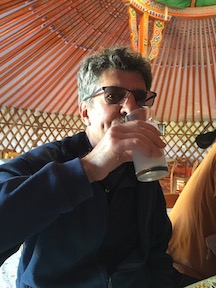 I am grateful to ISAW for making possible my year in residence and research overseas. Thanks to my research trip to Mongolia, I not only learned more about Pugu Yitu’s cultural preference and spiritual beliefs, I had my first taste of fermented mare’s milk!
I am grateful to ISAW for making possible my year in residence and research overseas. Thanks to my research trip to Mongolia, I not only learned more about Pugu Yitu’s cultural preference and spiritual beliefs, I had my first taste of fermented mare’s milk!